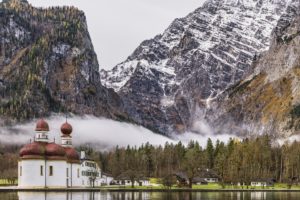 Henry Goodell, president of the Massachusetts Agricultural College, described how the medieval monks saved agriculture from decaying. Their accomplishments have left a legacy lasting 1500 years.
Henry Goodell, president of the Massachusetts Agricultural College, described how the medieval monks saved agriculture from decaying. Their accomplishments have left a legacy lasting 1500 years.
He explains how they did it in the most unlikely and difficult ways. They searched for distant and inaccessible places to live in solitude. They then drained swamps and cleared forests so the area would be fit to be inhabited. New cities were built around their monasteries.
The terrain around Thorney Abbey in England, for example, was a maze of dark streams, wide pools, periodically overflowing marshes, fallen trees, and rotting plants. It was infested with dangerous animals and clouds of insects.
Left to its own devices, without man’s ordering and protective hand, nature was in chaos.
Five centuries later, William of Malmesbury (1096-1143) thus described the same terrain around the Abbey:
It is a counterfeit of Paradise, where the gentleness and purity of heaven appear already to be reflected…
Not an inch of land as far as the eye can reach lies uncultivated. Here the soil is hidden by fruit trees; there by vines stretched upon the ground or trailed on trellises.
Nature and art rival each other, the one supplying all that the other forgets to produce. O deep and pleasant solitude!
Thou hast been given by God to the monks, so that their mortal life may daily bring them nearer to heaven.1
Later, Protestantism reduced Thorney Abbey to ruins, which still attract and enthrall tourists today.
Wherever they went, the monks introduced grain farming, manufacturing techniques and production methods that have never been seen before. They developed breeds of animals, cultivated varieties of seeds, brewed beer, harvested honey and fruits.
What Does Saint Thomas Say About Immigration?
In Sweden, they created the corn trade; in Parma, cheese making. In Ireland, they established salmon farms. Everywhere they went, they planted the best vineyards. They even invented beer in its present form, and champagne!
They built reservoirs for days of drought. The monasteries of Saint-Laurent and Saint-Martin even channeled water to Paris.
In Lombardy, they taught peasants the irrigation methods that made them rich. Every monastery was a school to help inhabitants exploit the region’s resources.
One would be hard-pressed to find any group anywhere whose contributions were so varied, significant and indispensable, as those provided by the monks of the West. They did this at a time of misery and despair that followed the fall of the Roman Empire.
What does Saint Thomas Aquinas say about Marriage?
Historian Thomas Woods rightly asks: Who else in history can claim such feats?
Truly, no matter how hard one might look, there is no one else.
[like url=https://www.facebook.com/ReturnToOrder.org]
Last updated August 2, 2018.


